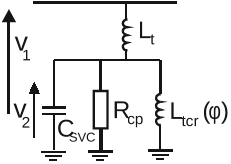




Did you find this useful? Give us your feedback













215 citations
128 citations
76 citations
73 citations
55 citations
13,467 citations
...To enable a wider frequency range dynamic analysis and coupling with the static coordinate frame, the above model is converted to the static frame using Park’s transformation [8], [12]....
[...]
183 citations
...The modeling principle reported in [6] employs rotating vectors that are difficult to use with stability studies, and only considers the open loop configuration....
[...]
107 citations
...The model presented in [2] uses a special form...
[...]
102 citations
...The importance of having a state-space represented, linear continuous system model, is well recognized in [4]....
[...]
92 citations
A PLL is typically used with thyristor converters to provide the reference signal that follows the synchronizing line voltage or current.
It is seen that the PLL gains have significant influence on the system dynamics and that the frequency of the dominant oscillatory mode reduces, accompanied by a small reduction in mode damping (branch “a”).
In order to link the d-q components of the rotating susceptance (15) with the controller module, these components are further converted to magnitudeangle components using the x-y to polar co-ordinate transformation [8].
Model verification in the time and frequency domains against a PSCAD simulation confirmed very high accuracy for f<25Hz, and fair accuracy even beyond the first harmonic frequencies.
The input matrices, Bij, take the second index “j” from the particular input-side connecting subsystem (i.e.: Bacco is the AC model input matrix that takes input signals from the controller), and the output matrices Cik have the second index “k” associated with the linking subsystem that takes the particular output vector.
Regarding the overall time and frequency domain responses, and being aware of the phase response errors, it can be concluded that the model has reasonably good accuracy when employed as a design and analysis tool for phenomena such as subsynchronous resonance, or interactions with other fast FACTS/HVDC controls.
Although not shown in Figure 10, the increase in the PLL gains increases the speed of response and it is suggested that this effect on the positioning of the dominant mode can be exploited in the design stage to improve performance, or to avoid negative interactions at a particular frequency.
The test system in use consists of a SVC connected to an AC system that is represented by an equivalent impedance and a local load, as shown in Figure 1.
Assuming small perturbations around the steady state the authors have:)( 222 vvv o ∆+= (9) )/(// tcrtcrtcr LLL 111 0 ∆+= . (10) Small perturbations are justified assuming an effective voltage control at the nominal value.
As the gains are reduced, the eigenvalues migrate from the original “x” to the location “o”, representing ten times reduced gains.